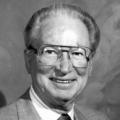In Memoriam... Dr. Sidney Esensten, P000336... February 7, 2006Dr. Sidney Esensten By Irene L. Mandra
His wife, Gloria of 61 years, survives him, as does his brother Jack, three sons, William, Richard and Tom, and their wives, and four grandchildren, Jeremy, Jennie, Joseph, and Benjamin. Dr. Esensten was born in 1923 in St. Paul, Minnesota, the fourth of five sons. His mother wanted him to become a rabbi however, with the passing of his parents, he was raised by his oldest brother and sent to medical school. Upon graduation from the University of Minnesota Medical School, he was commissioned as a Second Lieutenant in the Army and served his active duty time in Seattle, Kansas and Texas until discharged. In August of 1950, he was called back to active duty and sent to Korea as a physician for the 25th Infantry Division. He was captured by troops of the Chinese Communist Forces on November 22, 1950 in North Korea. They were marched to a temporary camp at Sombakol. The winter of 1950 – 1951 was the coldest in Korea in 100 years. A defining moment came on the day that he had to treat 50 POW suffering from pneumonia with enough penicillin for just one, so he a gave placebo to 40 of them – they all died. So did the ten who receive a diluted dose of penicillin. “I had played God,” Esensten said, “None of the people who died should have died.” “They were kids, 10 and 20 years old.” There were more horrors to come. Seventy-five percent of the U.S. soldiers captured during this time perished in the P.O.W. camps from starvation, disease and torture. He and the other prisoners were moved to Camp 5 at Pyoktong, a bombed out village on the banks of the Yalu River in North Korea that served as a major Communist prison camp. While there, he served as one of the camp’s physicians. After three years of horrific internment, Dr. Esensten walked across the Freedom Bridge at Panmunjom on October 3, 1953. Dr. Esensten continued his military service in the Army Reserve and retired as a Major. He gave testimony to the U.S. Congress regarding treatment of P.O.W.s by the Chinese and North Koreans and spoke about his experiences to anyone who would listen. In addition, he provided advice to the Army regarding recommended changes to rules of conduct for prisoners-of-war. “I want to make it perfectly clear,” he said, “that except for the POW that were wounded at the time of capture, all the deaths in the Communist prison camps were caused directly or indirectly by starvation, exposure, torture, purposeful kill, and harassment by the enemy.” On the long marches, it was all but impossible for any of the captured physicians to do much for the men except to offer encouragement, but in the temporary camp at Sombakol, which the men called the “Valley.” He noticed that POW captured as a unit almost always did better than people who were captured as individuals. However he, and another American physician, Major Clarence L. Anderson, managed to set up a temporary hospital. In the camps, they faced the daunting challenge of keeping men alive without proper facilities and little or no medicine. In one month alone, they lost over 1,000 men. Both men tried to keep a record of how many prisoners died and causes of death, but the Chinese would not allow it. In spite of the many physical and psychological challenges he and his fellow POW had to endure, Dr. Esensten said that he came out of his experience a better man. After Korea, he returned to his medical practice at the Belzer Clinic, later known as the Fairview Clinic. He was very proud of the fact that throughout his career he delivered over 10,000 babies. He often spoke to medical groups about diseases and conditions he encountered as a P.O.W. In addition, he took every opportunity to speak with groups and share his experiences with Communism and how it was really practiced. As an active member of Temple Israel, Sidney made a bold commitment to youth when, in 1965, he and several others funded the purchase of a large Boy Scout camp on Lake Minnetonka, now known as Camp Teko. In 1985, when he was chief of staff at Fairview Riverside Hospital where he gave a speech that was published as “Memories of Life as a POW 35 Years Later” in the July – August 1997; September – December 1997: and January – February 1998 issues of The Graybeards, the official magazine of the Korean War Veterans Association. Major Esensten continued to practice medicine until he retired in 1999 at the age of 76. He continued to write about his personal experiences and on the chronic effects of POW life on former prisoners. In spite of his first-hand understanding of the POW experience, or perhaps because of it, Dr. Esensten admitted that he suffered from nightmares some three or four times a week. We, the families of POW/MIA ,wish to
say goodbye to the good doctor who took care of our loved ones the best he knew how. God Bless you Doctor Sidney Esensten!
(Posted 3/1/06) |
 Dr. Sidney Esensten,
life long Twin Cities resident and noted physician died of kidney failure on February 7, a day
before his 83rd birthday, at his winter home in Rancho Mirage, CA.
Dr. Sidney Esensten,
life long Twin Cities resident and noted physician died of kidney failure on February 7, a day
before his 83rd birthday, at his winter home in Rancho Mirage, CA.